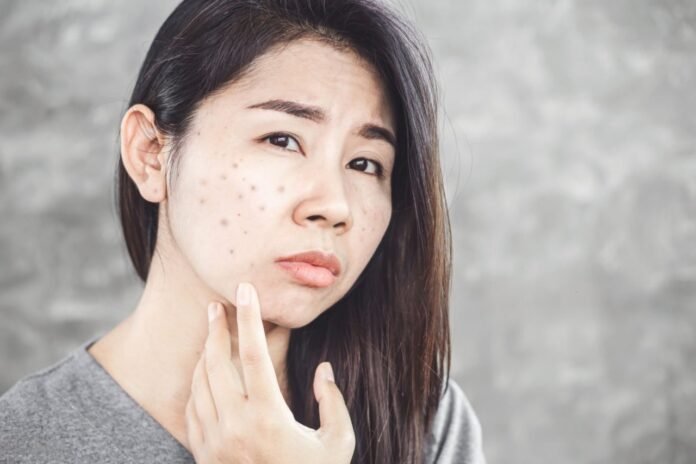Dark spots and hyperpigmentation are common skin concerns that affect people of all skin tones and types. These spots occur when the skin produces excess melanin, often triggered by sun exposure, inflammation, acne, or hormonal changes. Knowing the cause of your pigmentation is the first step toward treating it safely and effectively.
There are several types of hyperpigmentation:
- Post-inflammatory hyperpigmentation (PIH): Occurs after acne, cuts, or irritation.
- Sunspots (solar lentigines): Result from prolonged UV exposure.
- Melasma: Often caused by hormonal changes, such as during pregnancy or due to birth control use.
Each type may require a slightly different treatment approach, but safety and consistency are key to all.
The Science Behind Skin Discoloration
Melanin is the pigment that gives skin its color. When melanin production becomes uneven, it leads to patchy discoloration. This can be worsened by:
- UV rays from the sun or tanning beds
- Hormonal fluctuations
- Skin trauma, such as acne or injury
- Certain medications or cosmetic products
Fading hyperpigmentation takes time and patience. Using harsh products can damage the skin barrier and lead to further darkening, so gentle, targeted care is essential.
Safe and Effective Ingredients That Target Dark Spots
When selecting skincare products to reduce hyperpigmentation, look for ingredients backed by dermatological science. Here are the most effective and safe options:
1. Vitamin C (Ascorbic Acid)
Vitamin C is a powerful antioxidant that brightens the skin, reduces melanin production, and protects against environmental damage. It’s best used in the morning under sunscreen.
2. Niacinamide (Vitamin B3)
This calming ingredient reduces inflammation and inhibits melanin transfer to skin cells. It works well for sensitive skin and can be combined with other brightening agents.
3. Alpha Arbutin
A gentle skin-lightening agent derived from plants, alpha arbutin reduces dark spots without irritating the skin. It’s safe for daily use.
4. Azelaic Acid
Ideal for acne-prone skin, azelaic acid fights both bacteria and pigmentation. It’s often prescribed for melasma and post-acne marks.
5. Tranexamic Acid
A relatively new player in topical skincare, this acid reduces melanin synthesis and is especially effective for melasma.
6. Kojic Acid
This ingredient, derived from mushrooms, helps block tyrosinase, an enzyme involved in melanin production. It’s best used in combination with other treatments.
How to Build a Safe Hyperpigmentation Routine
A consistent routine is vital for fading dark spots. Here’s a simple and safe morning and evening routine for targeting hyperpigmentation:
Morning Routine
- Cleanser: Use a gentle, non-stripping cleanser.
- Antioxidant Serum: Apply vitamin C or niacinamide to brighten and protect.
- Moisturizer: Hydrate the skin barrier.
- Broad-Spectrum Sunscreen: SPF 30 or higher is crucial every single day.
Evening Routine
- Cleanser: Wash off the day’s grime gently.
- Treatment Serum: Use ingredients like alpha arbutin, tranexamic acid, or azelaic acid.
- Moisturizer: Support repair and hydration overnight.
Remember to introduce new products gradually and patch test to avoid irritation.
Lifestyle Tips to Prevent and Manage Dark Spots
Topical treatments are important, but your overall lifestyle also plays a major role. Here are habits that support healthy, even-toned skin:
- Always wear sunscreen: UV rays worsen existing pigmentation and cause new spots.
- Avoid picking or popping pimples: This can lead to PIH.
- Manage hormonal fluctuations: If melasma is triggered by birth control or pregnancy, speak with a dermatologist.
- Eat a balanced diet: Foods rich in antioxidants (like berries, leafy greens, and nuts) support skin repair.
- Stay hydrated: Hydration helps flush toxins and supports skin healing.
Professional Treatments for Stubborn Hyperpigmentation
If over-the-counter products are not working, professional treatments can help. However, they must be administered by trained dermatologists or skincare professionals.
1. Chemical Peels
These use acids like glycolic or lactic acid to exfoliate the skin and reveal a more even tone.
2. Laser Treatments
Fractional laser resurfacing or intense pulsed light (IPL) can target deep pigmentation but must be carefully performed on darker skin tones to avoid complications.
3. Microneedling
Microneedling boosts collagen and can help fade acne scars and discoloration.
4. Prescription Creams
Dermatologists may prescribe hydroquinone, tretinoin, or combination creams for persistent pigmentation.
Tip: Never attempt professional-grade treatments at home. Inappropriate use can worsen hyperpigmentation or lead to scarring.
Natural Remedies: Are They Safe?
Many people turn to natural solutions like lemon juice or apple cider vinegar. However, these can be too harsh or unpredictable, especially for sensitive skin. Instead, opt for naturally derived but clinically supported ingredients like:
- Licorice Root Extract
- Green Tea Extract
- Mulberry Extract
- Rosehip Oil (rich in vitamin A and fatty acids)
Natural doesn’t always mean safe — always consult with a professional or dermatologist before trying DIY methods.
How Long Does It Take to See Results?
Fading dark spots is a slow process. Depending on the severity and type of hyperpigmentation, results can take anywhere from 4 to 12 weeks, or longer. Key factors that affect your progress:
- Skin type and tone
- Underlying cause of pigmentation
- Consistency of skincare routine
- Sun protection habits
Stay consistent, take progress photos, and adjust your routine under guidance if needed.
Final Thoughts
Dark spots and hyperpigmentation are treatable, but require a combination of science-backed products, professional guidance, and protective habits. Start slow, protect your skin from the sun, and focus on nourishing your skin barrier — the foundation of healthy skin.
By building a gentle, targeted routine and understanding the cause of your pigmentation, you can safely and gradually restore a more even, radiant complexion.



